THE NATIONAL UNIVERSITY OF PHARMACY Pharmacology department Lecture








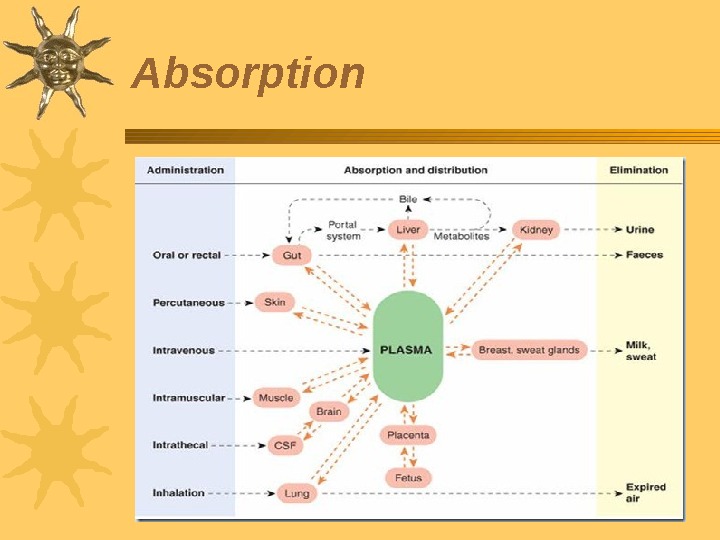

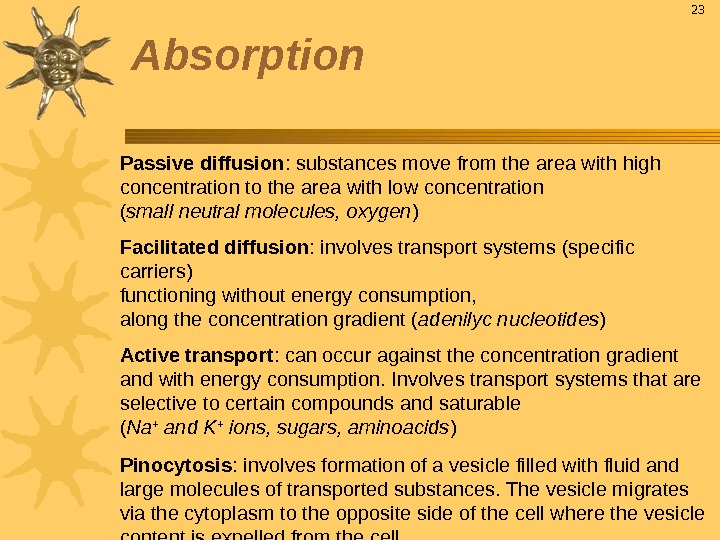

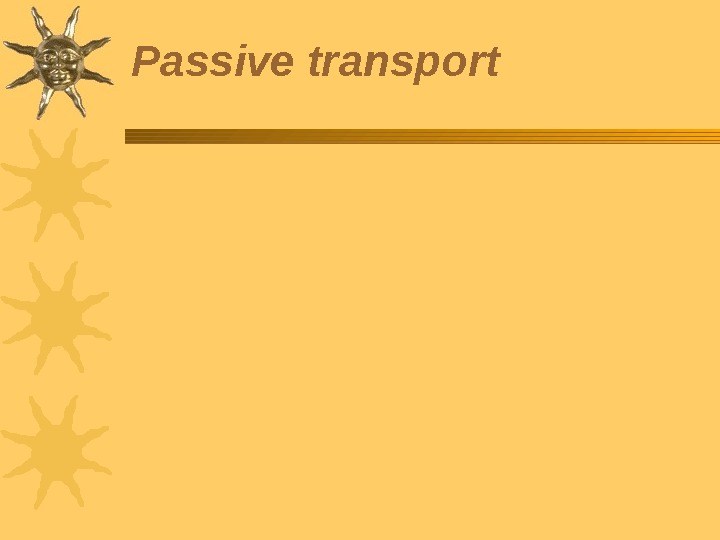

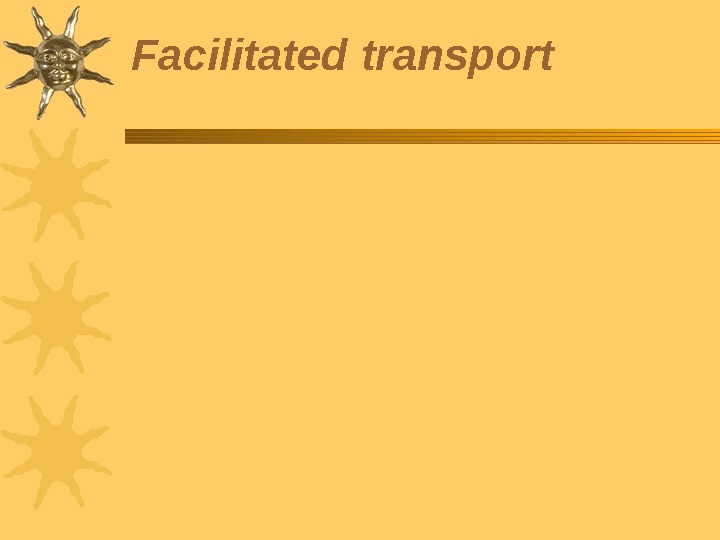








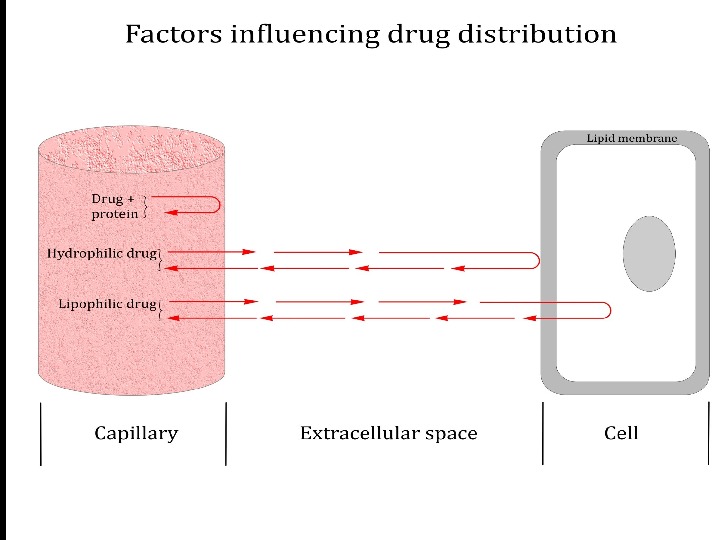























general_pharmacology_ii_part.ppt
- Размер: 3.4 Mегабайта
- Количество слайдов: 47
Описание презентации THE NATIONAL UNIVERSITY OF PHARMACY Pharmacology department Lecture по слайдам
 THE NATIONAL UNIVERSITY OF PHARMACY Pharmacology department Lecture topic: “ GENERAL PHARMACOLOGY II ” Olga Tovchiga Ph. D (pharmacology, pharm. sc. ) assistant of the Department of Pharmacology
THE NATIONAL UNIVERSITY OF PHARMACY Pharmacology department Lecture topic: “ GENERAL PHARMACOLOGY II ” Olga Tovchiga Ph. D (pharmacology, pharm. sc. ) assistant of the Department of Pharmacology
 Objectives I. Pharmacokinetics Absorption Bioavailability Distribution Drug metabolism Excretion II. Combined action of drugs
Objectives I. Pharmacokinetics Absorption Bioavailability Distribution Drug metabolism Excretion II. Combined action of drugs
 Pharmacokinetics (from Greek pharmakon — medicine, kineo — move) Pharmacokinetics is the part of pharmacology that deals with compound absorbtion, distribution in the body, storage, metabolism and exretion. What a body does to a drug bodydrug
Pharmacokinetics (from Greek pharmakon — medicine, kineo — move) Pharmacokinetics is the part of pharmacology that deals with compound absorbtion, distribution in the body, storage, metabolism and exretion. What a body does to a drug bodydrug
 Pharmacokinetics Based on the hypothesis that the action of a drug requires presence of a certain concentration in the fluid surrounding the target tissue. In other words, the magnitude of response (desirable or undesirable) depends on the concentration of the drug at the site of action
Pharmacokinetics Based on the hypothesis that the action of a drug requires presence of a certain concentration in the fluid surrounding the target tissue. In other words, the magnitude of response (desirable or undesirable) depends on the concentration of the drug at the site of action
 Pharmacokinetics Drug Movement in the Body Absorption Distribution Metabolism Excretion. ADME profile
Pharmacokinetics Drug Movement in the Body Absorption Distribution Metabolism Excretion. ADME profile
 Pharmacokinetics and Pharmacodynamics TISSUES BLOOD PLASMA depotdepot metabolism site of drug action (receptors) metabolites and conjugates adsorption excretion free substance bound substance metabolites conjugates
Pharmacokinetics and Pharmacodynamics TISSUES BLOOD PLASMA depotdepot metabolism site of drug action (receptors) metabolites and conjugates adsorption excretion free substance bound substance metabolites conjugates
 Absorption The usage of drugs starts with their administration into the organism or application onto body surface The route of administration defines the speed of onset of effect, its intensity and duration and, in certain cases, the drug activity There are several known absorbtion mechanisms Step 1 in ADME profile
Absorption The usage of drugs starts with their administration into the organism or application onto body surface The route of administration defines the speed of onset of effect, its intensity and duration and, in certain cases, the drug activity There are several known absorbtion mechanisms Step 1 in ADME profile
 Absorption
Absorption
 Absorption
Absorption
 Absorption of drugs from the gastrointestinal tract through the skin, respiratory and vascular walls is connected with several known mechanisms. Types of transport : • passive transport (simple diffusion, facilitated diffusion, ultrafiltration) • active transport • pinocytosis 22 Absorption Ion channel Carrier Pinocytosis Diffusion
Absorption of drugs from the gastrointestinal tract through the skin, respiratory and vascular walls is connected with several known mechanisms. Types of transport : • passive transport (simple diffusion, facilitated diffusion, ultrafiltration) • active transport • pinocytosis 22 Absorption Ion channel Carrier Pinocytosis Diffusion
 Passive diffusion : substances move from the area with high concentration to the area with low concentration ( small neutral molecules, oxygen ) Facilitated diffusion : involves transport systems (specific carriers) functioning without energy consumption, along the concentration gradient ( adenilyc nucleotides ) Active transport : can occur against the concentration gradient and with energy consumption. Involves transport systems that are selective to certain compounds and saturable ( Na + and K + ions, sugars, aminoacids ) Pinocytosis : involves formation of a vesicle filled with fluid and large molecules of transported substances. The vesicle migrates via the cytoplasm to the opposite side of the cell where the vesicle content is expelled from the cell 23 Absorption
Passive diffusion : substances move from the area with high concentration to the area with low concentration ( small neutral molecules, oxygen ) Facilitated diffusion : involves transport systems (specific carriers) functioning without energy consumption, along the concentration gradient ( adenilyc nucleotides ) Active transport : can occur against the concentration gradient and with energy consumption. Involves transport systems that are selective to certain compounds and saturable ( Na + and K + ions, sugars, aminoacids ) Pinocytosis : involves formation of a vesicle filled with fluid and large molecules of transported substances. The vesicle migrates via the cytoplasm to the opposite side of the cell where the vesicle content is expelled from the cell 23 Absorption
 Mechanism Direction Energy required Carrier Saturability Passive diffusion Along the gradient No No No Facilitated diffusion Along the gradient No Yes Active transport Against the gradient Yes Yes. Absorption
Mechanism Direction Energy required Carrier Saturability Passive diffusion Along the gradient No No No Facilitated diffusion Along the gradient No Yes Active transport Against the gradient Yes Yes. Absorption
 Passive transport
Passive transport
 Membranes and Absorption Lipid Bilayer Small, uncharged Large, uncharged Small charged ions H 2 O, urea, CO 2 , N 2 Glucose Sucrose H + , Na + , K + , Ca 2+ , Cl — , HCO 3 — DENIED!Swoosh!Hydrophobic Tails. Hydrophilic Heads
Membranes and Absorption Lipid Bilayer Small, uncharged Large, uncharged Small charged ions H 2 O, urea, CO 2 , N 2 Glucose Sucrose H + , Na + , K + , Ca 2+ , Cl — , HCO 3 — DENIED!Swoosh!Hydrophobic Tails. Hydrophilic Heads
 Facilitated transport
Facilitated transport
 Active transport
Active transport
 Pinocytosis
Pinocytosis
 Physical properties Physical state Solubility Medicinal forms Type of a medicinal form Size of drug particles Disintegration time Physiological factors p. H of GI fluids Ionization GI transit time Diseased state Gastric disorders Liver disorders Factors that influence the absorption
Physical properties Physical state Solubility Medicinal forms Type of a medicinal form Size of drug particles Disintegration time Physiological factors p. H of GI fluids Ionization GI transit time Diseased state Gastric disorders Liver disorders Factors that influence the absorption
 Bioavailability bioavailability is the proportion of the initial drug dosage that reaches blood plasma (systemic circulation) without changes after i. v injection — 100% bioavailability In bioavailability assessment, the area under the curve (AUC) is usually measured Says nothing about effectiveness. Systemic effect of a substance develops only after its entrance into the bloodstream from which it moves to tissues
Bioavailability bioavailability is the proportion of the initial drug dosage that reaches blood plasma (systemic circulation) without changes after i. v injection — 100% bioavailability In bioavailability assessment, the area under the curve (AUC) is usually measured Says nothing about effectiveness. Systemic effect of a substance develops only after its entrance into the bloodstream from which it moves to tissues
 Plasma concentration Time (hours)i. v. route oral route (AUC) o / (AUC) iv. Bioavailability
Plasma concentration Time (hours)i. v. route oral route (AUC) o / (AUC) iv. Bioavailability
 Bioavailability Not absorbed Destroyed by gut wall to systemic circulation. Destroyed by liver Dose Destroyed in gut
Bioavailability Not absorbed Destroyed by gut wall to systemic circulation. Destroyed by liver Dose Destroyed in gut
 Distribution Step 2 in ADME profile After absorption, drug enters the blood, than different organs and tissues The majority of drugs are distributed unevenly Distribution into the body compartments Plasma 3. 5 litres (heparin, plasma expanders) Extracellular fluid 14 litres , (tubocurarine, charged polar compounds) Total body water 40 litres (ethanol)Drugs more easily penetrate into most organs with intensive blood circulation (heart, liver, kidneys)
Distribution Step 2 in ADME profile After absorption, drug enters the blood, than different organs and tissues The majority of drugs are distributed unevenly Distribution into the body compartments Plasma 3. 5 litres (heparin, plasma expanders) Extracellular fluid 14 litres , (tubocurarine, charged polar compounds) Total body water 40 litres (ethanol)Drugs more easily penetrate into most organs with intensive blood circulation (heart, liver, kidneys)
 THE BODY COMPARTMENTS
THE BODY COMPARTMENTS

 Distribution of drugs in the body In the body drugs partially bind to other molecules and form extracellular and cellular depots Plasma proteins (especially albumins) are the most important extracellular depots Only free drug fraction can move through the membrane, render a pharmacological effect, undergo biotransformation and excretion Binding of drugs to proteins may be reduced in liver and kidney diseases, sepsis, burns, gastritis, enteritis, protein deficiency, and due to the drug interaction (if two drugs get bound with the same proteins)
Distribution of drugs in the body In the body drugs partially bind to other molecules and form extracellular and cellular depots Plasma proteins (especially albumins) are the most important extracellular depots Only free drug fraction can move through the membrane, render a pharmacological effect, undergo biotransformation and excretion Binding of drugs to proteins may be reduced in liver and kidney diseases, sepsis, burns, gastritis, enteritis, protein deficiency, and due to the drug interaction (if two drugs get bound with the same proteins)

 Distribution
Distribution
 Important for clinical pharmacology It is the presumed volume of liquid in which a drug can be distributed (assuming that drug concentrations in plasma and other liquid media of the body is equal)Distribution The apparent volume of distribution Plasma 3. 5 litres Extracellular fluid 14 litres Total body water 40 litres V d = Total amount of drug in the body Drug concentration in plasma Liphophilic compounds with wide distribution have high value of V dd Drugs that only circulate in blood have low value of V dd
Important for clinical pharmacology It is the presumed volume of liquid in which a drug can be distributed (assuming that drug concentrations in plasma and other liquid media of the body is equal)Distribution The apparent volume of distribution Plasma 3. 5 litres Extracellular fluid 14 litres Total body water 40 litres V d = Total amount of drug in the body Drug concentration in plasma Liphophilic compounds with wide distribution have high value of V dd Drugs that only circulate in blood have low value of V dd
 25 Distribution Biological barriers substantially influence drug distribution There are such biological barriers: capillary wall cell membranes blood-brain barrier placental barrier blood-brain barrierblood brain astrocyteendothelium basal membrane
25 Distribution Biological barriers substantially influence drug distribution There are such biological barriers: capillary wall cell membranes blood-brain barrier placental barrier blood-brain barrierblood brain astrocyteendothelium basal membrane
 Biotransformation of drugs (drug metabolism) is the process of drugs (xenobiotics) conversion into metabolites that are easily dissolved in water and can be excreted by the kidneys. Many enzymes participate in drug biotransformation, the most important among them are microsomal enzymes of the liver , they do not have substrate specifity Non-microsomal enzymes are localized in the liver and in the intestines, lungs, kidneys, blood, placenta and others. 27 Metabolism Step 2 in ADME profile Most drugs undergo biotransformation in the body Drug metabolism determines drug dosage regimen.
Biotransformation of drugs (drug metabolism) is the process of drugs (xenobiotics) conversion into metabolites that are easily dissolved in water and can be excreted by the kidneys. Many enzymes participate in drug biotransformation, the most important among them are microsomal enzymes of the liver , they do not have substrate specifity Non-microsomal enzymes are localized in the liver and in the intestines, lungs, kidneys, blood, placenta and others. 27 Metabolism Step 2 in ADME profile Most drugs undergo biotransformation in the body Drug metabolism determines drug dosage regimen.
 Lipid soluble drug Water soluble drug or Active drug Inactive metabolite or Prodrug Active drug. METABOLISM
Lipid soluble drug Water soluble drug or Active drug Inactive metabolite or Prodrug Active drug. METABOLISM
 Hepatic microsomal enzymes (oxidation, conjugation)Extrahepatic microsomal enzymes (oxidation, conjugation) Hepatic non-microsomal enzymes (acetylation, sulfation, GSH, alcohol/aldehyde dehydrogenase, hydrolysis, ox/red)Drug Metabolism
Hepatic microsomal enzymes (oxidation, conjugation)Extrahepatic microsomal enzymes (oxidation, conjugation) Hepatic non-microsomal enzymes (acetylation, sulfation, GSH, alcohol/aldehyde dehydrogenase, hydrolysis, ox/red)Drug Metabolism
 1. Metabolic transformation occurs through oxidation, reduction, hydrolysis In these reactions groups with active hydrogen atoms (oxy-, aminogroups)are formed 2. Conjugation Functional groups of a drug get bound with endogenous compounds such as glucuronic residues, sulfur and amino acids. Also methylation and acetylation can take place. Nb! Biotransformation can increase drug activity or toxicity Prodrugs – active molecule is formed in the body (sulphenamide is an active metabolite of omeprazole) “ Lethal synthesis “ – if the toxic metabolites are formed (acetaldehyde is the toxic metabolite of ethanol) 27 Metabolism Step 3 in ADME profile There are two main types of drugs biotransformation
1. Metabolic transformation occurs through oxidation, reduction, hydrolysis In these reactions groups with active hydrogen atoms (oxy-, aminogroups)are formed 2. Conjugation Functional groups of a drug get bound with endogenous compounds such as glucuronic residues, sulfur and amino acids. Also methylation and acetylation can take place. Nb! Biotransformation can increase drug activity or toxicity Prodrugs – active molecule is formed in the body (sulphenamide is an active metabolite of omeprazole) “ Lethal synthesis “ – if the toxic metabolites are formed (acetaldehyde is the toxic metabolite of ethanol) 27 Metabolism Step 3 in ADME profile There are two main types of drugs biotransformation
 34 METABOLISM
34 METABOLISM
 Metabolic rate depends on genetic factors. Induction and inhibition of metabolism enzymes influences the rate of metabolism of drugs. Induction of metabolism enzymes – increase of their activity – acceleration of the drug metabolism Inhibition of metabolism enzymes – decrease of their activity – retarding of the drug metabolism While the use of drugs with inductors or inhibitors drug doses should be adjusted. 30 Metabolism
Metabolic rate depends on genetic factors. Induction and inhibition of metabolism enzymes influences the rate of metabolism of drugs. Induction of metabolism enzymes – increase of their activity – acceleration of the drug metabolism Inhibition of metabolism enzymes – decrease of their activity – retarding of the drug metabolism While the use of drugs with inductors or inhibitors drug doses should be adjusted. 30 Metabolism
 Concentration of a drug in blood is variable because of the changes in biotransformation processes SUPRESSION OF METABOLISM DRUG CUMULATION INHIBITION of enzymes that provide metabolism by other drugs Side effects increase. Genetical polymorphism of enzymes that provide metabolism INDUCTION of enzymes that provide metabolism by other drugs Genetical polymorphism of enzymes that provide metabolism INTENSIFICATION OF METABOLISM CONCENTRATION OF A DRUG IN BLOOD IS LOW Insufficient effect
Concentration of a drug in blood is variable because of the changes in biotransformation processes SUPRESSION OF METABOLISM DRUG CUMULATION INHIBITION of enzymes that provide metabolism by other drugs Side effects increase. Genetical polymorphism of enzymes that provide metabolism INDUCTION of enzymes that provide metabolism by other drugs Genetical polymorphism of enzymes that provide metabolism INTENSIFICATION OF METABOLISM CONCENTRATION OF A DRUG IN BLOOD IS LOW Insufficient effect
 Drugs and their metabolites are mainly eliminated with urine and bile and sometimes with expiratory air, by salivary glands, sweat glands, gastric and intestinal glands, lacrimal glands, mammary glands (caution is needed when administering drugs to a nursing mother!) Ways of excretion Drugs 1. With urine Most drugs in the free state 2. With bile Penicillin, tetracycline, streptomycin, strychnine, quaternary ammonium derivatives 3. Through intestine Doxycycline, ionized organic acids 4. By lungs Inhalation anesthetics, iodides, camphor, ethanol, essential oils 5. With sweat Sulfonamides, thiamine 6. With saliva Penicillin sulfanilamides, salicylates, thiamine, benzodiazepines, ethanol 7. With milk Anticoagulants, antibiotics, thyrostatics, carbamazepine 31 Excretion Step 4 in ADME profile
Drugs and their metabolites are mainly eliminated with urine and bile and sometimes with expiratory air, by salivary glands, sweat glands, gastric and intestinal glands, lacrimal glands, mammary glands (caution is needed when administering drugs to a nursing mother!) Ways of excretion Drugs 1. With urine Most drugs in the free state 2. With bile Penicillin, tetracycline, streptomycin, strychnine, quaternary ammonium derivatives 3. Through intestine Doxycycline, ionized organic acids 4. By lungs Inhalation anesthetics, iodides, camphor, ethanol, essential oils 5. With sweat Sulfonamides, thiamine 6. With saliva Penicillin sulfanilamides, salicylates, thiamine, benzodiazepines, ethanol 7. With milk Anticoagulants, antibiotics, thyrostatics, carbamazepine 31 Excretion Step 4 in ADME profile
 Important for clinical pharmacology It shows the time necessary to decrease drug concentration in blood plasma by 50% It is used to adjust doses of drugs and intervals between the times of their administration in order to achieve stable drug concentration 90% of the drug is eliminated during the period that equals 4 t 1/2 is defined not only by the drug elimination from the body, but also by its biotransformation and storage t 1/2 The elimination half-life or « half-life » Excretion
Important for clinical pharmacology It shows the time necessary to decrease drug concentration in blood plasma by 50% It is used to adjust doses of drugs and intervals between the times of their administration in order to achieve stable drug concentration 90% of the drug is eliminated during the period that equals 4 t 1/2 is defined not only by the drug elimination from the body, but also by its biotransformation and storage t 1/2 The elimination half-life or « half-life » Excretion
 EXCRETION
EXCRETION
 Drug interactions Based on the change in drugs pharmacokinetics Based on the change in drugs pharmacodynamics Pharmaceutical interaction
Drug interactions Based on the change in drugs pharmacokinetics Based on the change in drugs pharmacodynamics Pharmaceutical interaction
 Synergism ( from Greek syn – together, ergos – work ) increase in effect of drugs used at the same time (unidirectional effects) Two types of drug synergism — Summing up or additive effects — Potentiation Drug interactions based on the change in drugs pharmacodynamics
Synergism ( from Greek syn – together, ergos – work ) increase in effect of drugs used at the same time (unidirectional effects) Two types of drug synergism — Summing up or additive effects — Potentiation Drug interactions based on the change in drugs pharmacodynamics
 Summing up or additive effects ( combination of analgesics ) The mechanisms of actions of both drugs are similar Summed effect represents the actual sum of effects of the individual drugs. E ff e c t , %
Summing up or additive effects ( combination of analgesics ) The mechanisms of actions of both drugs are similar Summed effect represents the actual sum of effects of the individual drugs. E ff e c t , %
 Potentiation ( neuroleptanalgesia ) The drugs differ in mechanism s of action The total effect exceeds the sum of effects of the individual drugs. E ff e c t , %
Potentiation ( neuroleptanalgesia ) The drugs differ in mechanism s of action The total effect exceeds the sum of effects of the individual drugs. E ff e c t , %
 Antagonism ( from Greek antagōnisma – struggle, conflict ) the ability of drug to decrease the effect of the other one Types of antagonism — direct (competitive) the same target but the opposite effect (contraction or relaxation of the same muscle ) — i ndirect (noncompetitive) different targets and the opposite effect Drug interactions based on the change in drugs pharmacodynamics
Antagonism ( from Greek antagōnisma – struggle, conflict ) the ability of drug to decrease the effect of the other one Types of antagonism — direct (competitive) the same target but the opposite effect (contraction or relaxation of the same muscle ) — i ndirect (noncompetitive) different targets and the opposite effect Drug interactions based on the change in drugs pharmacodynamics
 Antagonism Types of antagonism — two-way and one-way antagonism A blocker reliably eliminates the effects of a mimetic (activator) but a mimetic (activator) usually is ineffective against a background of a blocker Synergoantagonism Occurs when some effects of the combined drugs are intensified, and others are weakened. Drug interactions based on the change in drugs pharmacodynamics
Antagonism Types of antagonism — two-way and one-way antagonism A blocker reliably eliminates the effects of a mimetic (activator) but a mimetic (activator) usually is ineffective against a background of a blocker Synergoantagonism Occurs when some effects of the combined drugs are intensified, and others are weakened. Drug interactions based on the change in drugs pharmacodynamics
 Drug incompatibility Incompatibility is the weakening, full loss or change in the pharmacotherapeutic effect, intensification of side or toxic effects – Pharmacological incompatibility – in the body — Antagonistic combinations of drugs ( activator + blocker ) or drugs with food ( nialamide + chocolate , iron compounds + milk and others ) — Dangerous combinations of drugs ( astemisole + itraconazole ; cardiac glycosdes + calcium salts and others ) or drugs with food ( niphedipine + grapefruit and others ) or drugs with herbal preparations ( drugs decreasing blood coagulation + ginkgo or garlic ) Pharmaceutical incompatibility – during the production process, storage or mixing of the drugs in one syringe — physical — chemical — physico-chemical
Drug incompatibility Incompatibility is the weakening, full loss or change in the pharmacotherapeutic effect, intensification of side or toxic effects – Pharmacological incompatibility – in the body — Antagonistic combinations of drugs ( activator + blocker ) or drugs with food ( nialamide + chocolate , iron compounds + milk and others ) — Dangerous combinations of drugs ( astemisole + itraconazole ; cardiac glycosdes + calcium salts and others ) or drugs with food ( niphedipine + grapefruit and others ) or drugs with herbal preparations ( drugs decreasing blood coagulation + ginkgo or garlic ) Pharmaceutical incompatibility – during the production process, storage or mixing of the drugs in one syringe — physical — chemical — physico-chemical
 Thank you!
Thank you!
